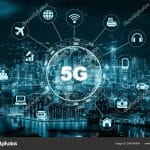Today, millions of users can be connected to a single network without data degradation or congestion, which has led to improved online services and better internet quality.
If the Internet is still where it was in the 3rd generation, we would have no access to smooth online services, and millions of users would not be able to connect to a single network across the world.
Join me in this article to learn more about 5G technology and its impact on connectivity in Nigeria and Africa.
Table of Contents
What is 5G Technology?
Fifth-generation technology is the most recent generation of cell phone network technology. 5G technology was developed by Qualcomm and Huawei, a Chinese telecommunications company, and both companies played a significant role in manufacturing 5G technology and equipment. China, however, remains the world-leading country with the most successful advancement in extensive deployment of the 5G network.
In comparison to the 3G networks, which were the first ever to make smartphones practical, the 5G network does not only offer faster data speed than LTE. Still, it has a higher capacity to handle data traffic as 5G download rates can be 100 times quicker than 4G at 20 gigabits per second (Gbps) peak data rates and 100+ megabits per second (Mbps) average data rates.
Possessing a lower latency than the 4th generation technology, 5G is designed to create a 100x increase in network efficiency.
Structure and Architecture of 5G Technology
The 5G technology modifies encoded data by using cell sites connected to a network with wireless technology or wired connections to transmit data through radio waves, significantly increasing the number of usable airwaves for carriers.
The structure of the 5G network is based on three main components:
-
The Core network (5G core or 5GC)
The new 5G core uses cloud-aligned service-based architecture (SBA), which improves the efficiency of the 5G network and speaks across all its functions, such as access and security management, subscriber authentication, quality of service, session management and traffic aggregation from end devices.
The 5G core can provide low latency, high-speed data transfer rates and network slicing capabilities, enabling real-time communication, increasing signal strength, simplifying network operations and enhancing end-user experience.
-
Radio access network
Radio access networks are one of the latest developments and critical components in wireless communication. It connects devices like smartphones to a network via a radio link.
A 5G Radio access network consists of a remote radio unit, antennas, a BBU and software interfaces. Data from a user reaches the network core after being received by a radio unit and then transformed into digital data by a BBU.
It also consists of a centralized cloud computing-based architecture for RAN, known as C-RAN, which enhances collaborative radio technology and supports real-time virtualization capabilities.
The radio access network is the backbone of 5G technology as it utilizes broadband and connectivity solutions to enhance user experiences and enable the development of innovations such as smart cities, autonomous vehicles, and Internet of Things (IoT).
-
User equipment (UE)
This refers to the device being operated by the user, such as phones, tablets or other wireless devices, to connect to a 5G network and communicate with other users worldwide over a 5G network. It is also known as the end-user device.
The 5G hardware infrastructure comprises a radio access network, which serves as a foundation for providing numerous services to users interconnected by the access network, which serves as a connection between the backbone and the edge networks and between the Radio access network and the Core network.
It comprises small cell base stations usually used in urban settings and cell towers commonly used outside defence population centres. These structures work hand in hand to enhance signal processing, data forwarding and data synchronization to bring about an effective and reliable wireless communication system.
Are you a writer? Do you desire to hone your writing skills? If so, join the Insight Writers Community.
Functions of 5G Technology
-
Network repository function (NPF)
All network functions of every 5G service provider are recorded centrally in the Network repository function. This is an essential element required for the execution of new service-based architecture in the 5G core. It provides a standard-based API which enables 5G service providers to register and find one another.
-
Service communication proxy (SCP)
This enables effective operation of the 5G network through proper observation of the network core and granting of routing control. The SCP takes advantage of the IT service mesh (ISTIO) and adds exceptional capabilities to make it 5G aware so that it can proceed with solutions to the many problems caused by the new Service-based architecture (SBA) in the 5G core.
-
Network slicing selection function( NSSF)
This is a system created to choose the best network slice available for the service requested by the user in a situation where various services are offered within a 5G environment.
-
Policy control function (PCF)
This system was created and designed using cloud-native principles to meet the demands of 5G services. The PCF enables you to reap and monetize the rewards of 5G through easy development and implementation of 5G network policies.
Read also: What is an Applicant Tracking System and How to Pass it?
-
Unified data management (UDM) and user data repository (UDR)
The UDM is a cloud-native server similar to the Home Subscriber Server(HSS) in LTE. The Unified Data Management system was created explicitly for 5G networks; it is responsible for granting access based on user subscriptions and creating credentials required for authentication.
It retrieves credentials from the UDR and sends them to the other network functions. The UDM network function supports key features of the 5G network, completes authentication processes and approves network access and roaming.
-
Network data analysis function (NWDAF)
The 5G network data analytics function is created to improve end-user experience and address market fragmentation and challenges in network analytics by generating insights, taking appropriate action, and adequately observing the production and consumption of core network data.
-
Authentication server function( AUSF)
This system function provides additional functionality and helps carry out activities concerned with the 5G Authentication and critical agreement method to manage privacy-protected subscription identifiers.
Impact of 5G technology in Nigeria and Africa as a Whole
The fifth-generation technology is up-and-coming as it opens up new opportunities for immense augmented and virtual reality experiences, increasing their accessibility to a broader audience through improvements in personalized experiences and interactive storytelling, made possible by low latency and high bandwidth capabilities of the 5G network.
In Nigeria and Africa, 5G would influence multiple sectors of the economy, such as transport, education, health, agriculture, logistics and insurance sectors, increasing productivity with immediate impact in developing Agri-technology, E-commerce, Telehealth and education technology.
5G technology is essential in expanding the digital economy. It would support the Fourth Industrial Revolution, characterized by edge-cutting technologies such as the Internet of Things (IoT) and Artificial intelligence (AI).
Through increased productivity and performance, 5G technology would optimize decision-making, service delivery and end-user experience, opening doors for innovations that would positively impact many sectors of the economy. From the early rollout of the 5G technology till 2030, 5G is expected to contribute about $26 billion to Africa’s economy.
Limitations of 5G Technology
-
Proximity
Its small cell coverage usually dictates the 5G network proximity performance. Hence, to ensure its efficiency, enterprise network teams are reshaping mobile landscapes with upgrades and additional sites to support 5G.
-
Cost
Implementation of the 5G technology comes with a price tag. The cost of developing 5G infrastructure or adaptations would be higher than existing cellular infrastructure.
-
Security
The invention of the fifth generation technology has led to an increase in cybercrime, as 5G networks would face new cybersecurity risks because the software used to manage the network might be more vulnerable to hackers.
-
Limited coverage
Due to its inability to cover large distances and the fact that 5G technology is a new upgrade to connectivity, the 5G network may be limited to Urban and densely populated areas, leaving the rural areas to experience slower deployment.
-
Weak upload speeds
The download speed in a 5G network does not match the upload speed. The download speed of the 5G network is incredibly high (1.96 gigabytes per second in some cases), while its upload speed rarely exceeds 100 megabytes per second.
Read also: Top 10 Ways Tech Companies in Nigeria can Stay Ahead of the Technology Curve.
Benefits of 5G Technology
-
Higher bandwidth
A wireless network bandwidth is simply its user capacity! The 5G technology has increased bandwidth, making data transfer and consumption easier, thereby increasing efficiency and improving end user experience.
-
Reliability
Due to new technology, such as edge computing and network slicing, the 5G network ensures that more devices can connect simultaneously without compromising performance.
-
Energy efficiency
5G networks are designed to be more energy efficient than their predecessors. It optimizes power consumption to reduce environmental effects.
Read also: Smart Home Technology: How it Works and The Benefits.
Conclusion
Fifth-generation technology enables the development of new technologies and the emergence of a new generation of interactive devices based on AI and machine learning.
The development of fifth-generation technology has brought about positive changes not only in Africa but the world at large. It has greatly impacted the technological aspect of Education, Health, Agriculture and other sectors, leading to an increase in efficiency and productivity in the world.
Subscribe to our newsletter to receive notifications of our latest posts.
Edited by Oluwanifemi Akintomide.
About Author
-
Obafaiye Precious is a content writer by skill. I love to articulate ideas, thoughts and memories into words, and am a deep lover of poetry. I'm Nigerian by birth, I love to write about my country and Africa at large!
I hope to become one of the best professional content writers.
So help me God!
Latest entries
 WomenApril 19, 2024Heart Attack in Women: Meaning, Causes, Symptoms and Prevention
WomenApril 19, 2024Heart Attack in Women: Meaning, Causes, Symptoms and Prevention
 CareerFebruary 6, 2024Industrial Design as a Course in Nigeria: The Hidden Treasures
CareerFebruary 6, 2024Industrial Design as a Course in Nigeria: The Hidden Treasures TechnologyJanuary 7, 2024A Beginner’s Guide to Quantum Computing
TechnologyJanuary 7, 2024A Beginner’s Guide to Quantum Computing

